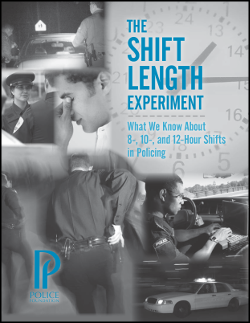
Most law enforcement agencies have traditionally deployed their patrol officers based on a 40-hour workweek in which personnel work five consecutive, 8-hour shifts, followed by two days off. In recent years, however, an increasing number of agencies have moved to some variant of a compressed workweek (CWW) schedule in which officers work four 10-hour shifts per week or three 12-hour shifts (plus a time adjustment to make up the remaining four hours of the standard 40-hour workweek).While this trend towards CWWs has been moving apace, there have been few, if any, rigorous scientific studies examining the advantages and disadvantages associated with these work schedules for officers and their agencies.
This report presents the results of the first known comprehensive randomized experiment of CWWs in law enforcement. The Police Foundation experiment was designed to test the impacts of three shift lengths (8-, 10-, and 12-hour) on performance, health, safety, quality of life, sleep, fatigue, alertness, off-duty employment, and overtime among police. In addition to scientifically rigorous research design and methodology, the number of reliable outcome measures employed to analyze the impact of shift length, including departmental data, laboratory simulations and exercises, and previously validated self-report instruments, make this study one of the most comprehensive ever undertaken in this area. The experiment was conducted in the Detroit (MI) and Arlington (TX) Police Departments between January 2007 and June 2009.
